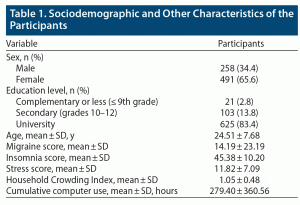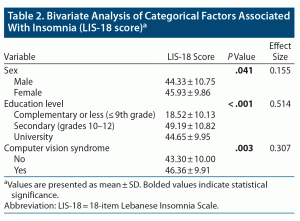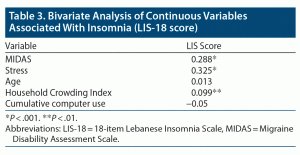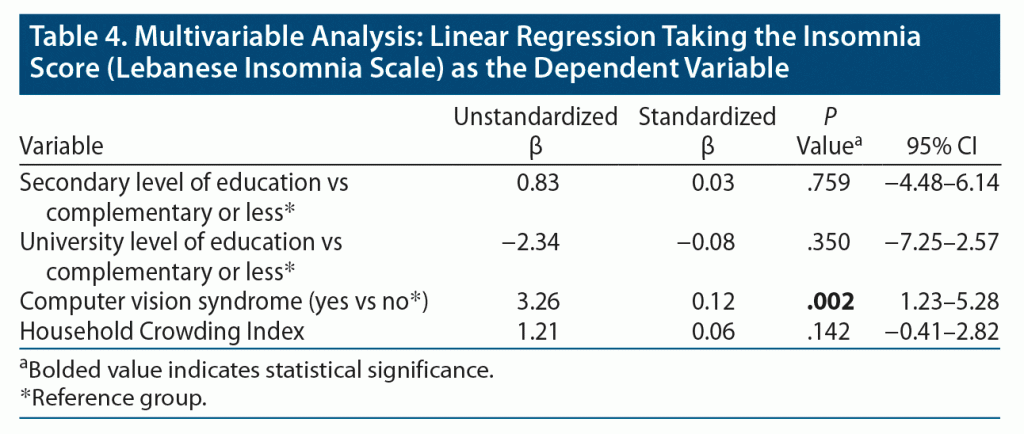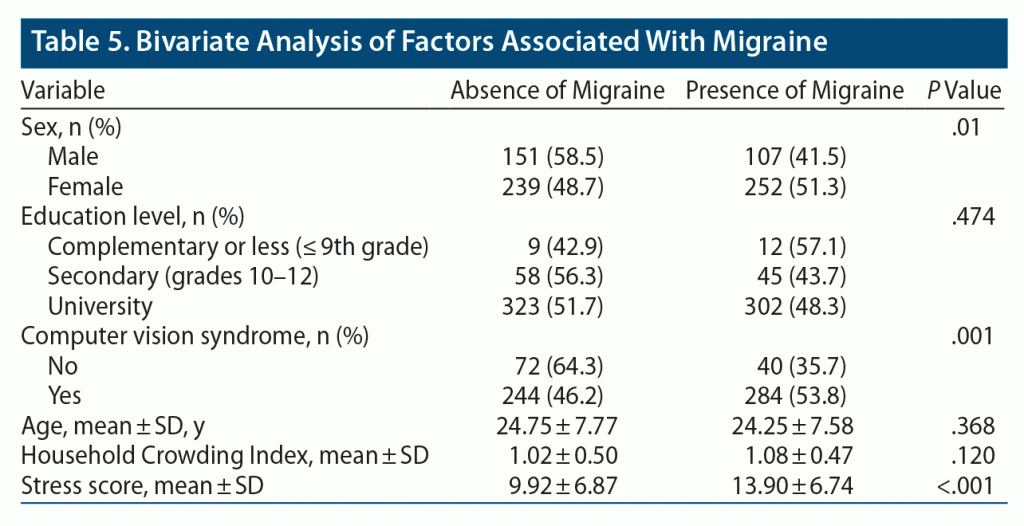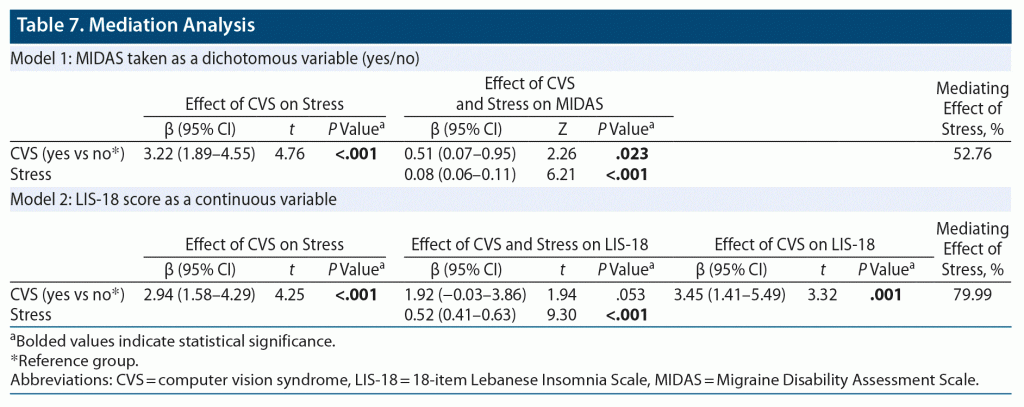ABSTRACT
Objective: Computer vision syndrome (CVS) refers to a group of ocular and extraocular symptoms due to prolonged digital device screen use. The objective of this study was to assess the correlation between CVS, insomnia, and migraine, taking into consideration stress as a mediating factor between these 3 variables.
Methods: This cross-sectional study was conducted between August 2020 and April 2021 using an online questionnaire filled out by 749 participants. Participants were enrolled using a snowball sampling technique. The link to the Arabic questionnaire was sent to the individuals by WhatsApp and by e-mail.
Results: The prevalence of CVS among participants was 70.5%. The presence of CVS (β = 3.26) was significantly associated with higher insomnia. The presence of CVS (adjusted odds ratio [aOR] = 1.66) and higher stress (aOR = 1.09) was significantly associated with higher odds of having migraine. Stress fully mediated the association between CVS and migraine by 52.76% and between CVS and insomnia by 79.99%.
Conclusion: CVS was significantly associated with insomnia and migraine. Stress mediated the relationship between CVS and insomnia, and between CVS and migraine. The precise mechanisms behind these associations were not evaluated in this study, with the hope that future research will provide more information on this topic.
Prim Care Companion CNS Disord 2022;24(4):21m03083
To cite: Akiki M, Obeid S, Salameh P, et al. Association between computer vision syndrome, insomnia, and migraine among Lebanese adults: the mediating effect of stress. Prim Care Companion CNS Disord. 2022;24(4):21m03083.
To share: https://doi.org/10.4088/PCC.21m03083
© 2022 Physicians Postgraduate Press, Inc.
aSchool of Medicine and Medical Sciences, Holy Spirit University of Kaslik, Jounieh, Lebanon
bSocial and Education Sciences Department, School of Arts and Sciences, Lebanese American University, Jbeil, Lebanon
cSchool of Medicine, Lebanese American University, Byblos, Lebanon
dInstitut National de Santé Publique, Epidémiologie Clinique et Toxicologie (INSPECT-LB), Beirut, Lebanon
eDepartment of Primary Care and Population Health, University of Nicosia Medical School, Nicosia, Cyprus
fFaculty of Pharmacy, Lebanese University, Hadat, Lebanon
gSchool of Pharmacy, Lebanese International University, Beirut, Lebanon
hCollege of Pharmacy, Gulf Medical University, Ajman, United Arab Emirates
iDepartment of Infectious Disease, Notre Dame des Secours University Hospital Center, Byblos, Lebanon
jDepartment of Infectious Disease, Bellevue Medical Center, Mansourieh, Lebanon
kPsychology Department, College of Humanities, Effat University, Jeddah, Saudi Arabia
lResearch Department, Psychiatric Hospital of the Cross, Jal Eddib, Lebanon
‡Last coauthors.
*Corresponding author: Souheil Hallit, PharmD, MSc, MPH, School of Medicine and Medical Sciences, Holy Spirit University of Kaslik, PO Box 446, Jounieh, Lebanon ([email protected]).
Computer and visual display terminals have become an integral part of our daily routines. Multiple screens are used daily and range from fixed computers used in offices to laptops used at home to smart phones slipped into pockets.1 Thus, these devices play an essential role in our professional, educational, and personal lives. Nonetheless, increased screen use time may lead to deleterious health disorders, especially eye problems known as computer vision syndrome (CVS).2
According to the American Optometric Association, CVS is a group of eye- and vision-related symptoms encountered due to the prolonged use of computers, laptops, cell phones, tablets, e-readers, and other digital devices.3,4 These symptoms include burning, itching, foreign body sensation, excessive tearing, excessive blinking, eye redness, eye pain, heavy eyelids, dryness, blurred vision, double vision, difficulty focusing on near objects, photophobia, colored halos around objects, and worsening eyesight feeling.5 Prolonged computer use can also cause some extraocular symptoms such as headache, backache, neck pain, shoulder pain, and numbness of the hands or fingers.6 CVS affects approximately 60 million people worldwide, with millions of new cases occurring every year.7
Moreover, heavy computer use can lead to difficulties falling or staying asleep, also known as insomnia.8 Excessive computer use, as well as an increase in the number of hours spent on the computer, increases the risk of CVS.9–11 CVS is associated with poor overall sleep quality.12 The association between CVS and insomnia, the most common sleep disorder, has been previously established.13 Light-emitting diodes have become the most common source of light in electronic devices, and optic radiation emitted at short wavelength, especially blue light, is identical to the melatonin suppression peak sensitivity.2 Therefore, light emitted from computer screens can interfere with the normal circadian rhythm by inhibiting the secretion of melatonin (sleep hormone).2 It is also known that blue light is a major cause of digital eyestrain.14 As a result, it is critical to investigate the impact of CVS on insomnia. The blue light emitted from computer screens not only causes insomnia but also worsens or triggers migraine attacks.15 Migraines are periodic attacks of throbbing headache usually on one side of the head.16 Consequently, screen brightness, duration of exposure, flicker frequency, viewing distance, and blue light exposure are major risk factors for triggering screen headaches15 by stimulating retinal cones that transmit signals to the light-sensitive trigeminovascular thalamic neurons and then to the cortex.17
Stress is defined as the way in which people realize and identify their problems, how they react to them and attempt to cope with them, and the “cost” of doing so.18 Stress is also present as a trigger for migraine attacks in almost 67% of individuals.19 Stress has been found to be the most frequent trigger of acute migraine attacks.20 It has been shown that stress is not only a migraine trigger, but also a risk factor for the development of chronic migraine from episodic migraine.21 Stressful life events induce insomnia as well. Stress was found to be a strong determinant of insomnia, with each new stressor increasing the chances of having insomnia by 19%.22 Stress severity was also considered to be a significant driver of insomnia.22 The stress-insomnia relationship is affected by sleep reactivity. In other words, individuals with higher levels of sleep reactivity were prone to experience stress-induced insomnia more than those with lower levels of sleep reactivity.23
Currently, CVS is becoming an important public health issue, especially after the enhancement of online teaching due to the coronavirus disease 2019 (COVID-19) pandemic.24 Excessive use of screens has led to increased prevalence of CVS and deterioration in the quality of life.11 However, studies showing the relation of CVS with stress, insomnia, and migraine are lacking and mostly absent. Also, there are no Lebanese studies available in this regard. Therefore, the objective of this study was to assess the correlation between CVS, insomnia, and migraine, taking into consideration stress as a mediating factor between these 3 variables, among a sample of Lebanese adults. The findings of this study may be a first step toward implementing preventive measures to avoid CVS-related symptoms.
METHODS
General Study Design
This cross-sectional research was carried out between August 2020 and April 2021 using an online questionnaire targeting all digital device users from all districts of Lebanon (Mount Lebanon, Beirut, North, South, and Bekaa). Data collection was conducted during the lockdown imposed by the government due to the COVID-19 pandemic; hence, participants were enrolled using a snowball sampling technique. The study’s purpose was stated clearly to all participants. Participation in this study was anonymous, respecting the privacy of all participants. The link to the Arabic questionnaire was sent to the individuals by WhatsApp and by e-mail. Participants were asked to send the link to other individuals who use digital devices.
Sample Size Calculation
According to the G-power software,25 and based on an effect size of f2 = 2%, an α error of 5%, a power of 80%, and taking into consideration 10 factors to be entered in the multivariable analysis, the results showed that a minimal number of 395 was needed.
Questionnaire
The questionnaire comprised closed and semi-open questions divided into 5 sections, including the informed consent in the first section. This consent gives the participants access to the rest of the questions. The participants’ sociodemographic characteristics, including age, sex, region, education level, occupation, and Household Crowding Index, were assessed in the second section. The latter reflects the socioeconomic status of the participants and was calculated by dividing the number of persons in the house by the number of rooms (excluding the bathrooms and the kitchen).26 Participants’ ocular health problems and the way they use their computer screens were targeted in the third section. This section was adapted from previous research on CVS27 and included questions about duration of computer use, refractive errors requiring spectacle use, and awareness of this syndrome. A cumulative number of hours of computer use was calculated by multiplying the number of years of computer use by the number of days of computer use per week by the number of hours of use per day.
The Computer Vision Syndrome Scale, designed by Seguí et al,6 was used in the fourth section to measure the frequency and intensity of 16 symptoms related to improper computer usage; each symptom was considered 1 item in the questionnaire. Participants with a total score ≥ 6 were considered to have CVS (Cronbach α = 0.78).
Migraine, insomnia, and stress scales were included in the last section. Migraine was assessed using the Migraine Disability Assessment Scale (MIDAS).28,29 The MIDAS is frequently used to measure headache-related disability over the last 3 months and was validated in Lebanon.28 After answering 5 questions, the number of days per question was added to grade migraine-related disability: grade I (score: 0–5) for little or no disability, grade II (score: 6–10) for mild disability, grade III (score: 11–20) for moderate disability, and grade IV (score: > 21) for severe disability29 (Cronbach α = 0.812).
Insomnia was evaluated using the Lebanese Insomnia Scale (LIS-18).30 LIS-18 questions covered all aspects of insomnia, including sleep thoughts, feelings, physical sensation, and behaviors; sleep quality and patterns; factors related to sleep disturbances; and daytime sleepiness and impact on daily functioning and quantity of sleep. Answers were measured on a 6-point Likert scale from 0 = never to 5 = always, with higher scores indicating more insomnia (Cronbach α = 0.821).
Stress was assessed using the Beirut Distress Scale (BDS-10).31 This scale was used to measure the level of psychological distress among computer users. It is a 10-question scale, wherein answers are evaluated on a 5-point Likert scale: 0 (never) to 4 (always), with higher scores reflecting more stress (Cronbach α = 0.821).
The part of the questionnaire related to CVS and the Computer Vision Syndrome Scale was translated from English to Arabic by 1 psychologist and then back to English by another psychologist. Discrepancies between the 2 English versions were resolved by consensus. A pilot study was done with 10 participants before starting data collection. Some linguistic modifications were made, and ambiguous questions were clarified. The data of those 10 people were not included in the final database.
Statistical Analysis
Statistical analysis was performed using SPSS software version 23. The LIS-18 score had a normal distribution since the skewness and kurtosis values varied between −1 and +1.32 These conditions consolidate the assumptions of normality in samples larger than 300.33 Accordingly, the Student t test was used to check for an association between LIS-18 score and dichotomous variables (ie, sex and marital status), while the analysis of variance test was used to compare between 3 or more means (ie, education level and monthly income). Pearson correlation test was used to correlate 2 continuous variables (ie, age, body mass index, depression, anxiety, stress, and impulsivity). A stepwise linear regression was conducted taking the LIS-18 score as the dependent variable.
The MIDAS score was not normally distributed (skewness and kurtosis outside the −1 and +1 interval); therefore, it was dichotomized according to the median (6). The χ2 test was used to compare categorical variables, whereas the Student t test was used to compare 2 means. A backward logistic regression was conducted taking the dichotomous MIDAS as the dependent variable. All factors that showed an effect size or correlation > 0.24 in the bivariate analysis were entered as independent variables in the linear and logistic regressions to have parsimonious models.34
Mediation Analysis
The PROCESS for SPSS macro version 3.4 model 435 was used to calculate 3 pathways. Pathway A determined the regression coefficient for the effect of the presence/absence of CVS on stress; pathway B examined the association between stress and LIS-18/MIDAS scores, independent of the presence/absence of CVS; and pathway C estimated the total and direct effect of the presence/absence of CVS on LIS-18/MIDAS scores. Pathway AB calculated the indirect intervention effects. To test the significance of the indirect effect, the macro-generated bias-corrected bootstrapped 95% confidence intervals should not pass zero.35 The covariates that were included in the mediation model were those that showed significant associations with the dependent variables in the bivariate analysis. P < .05 was considered significant.
RESULTS
Sociodemographic and Other Characteristics of the Participants
The mean ± SD age of the participants was 24.51 ± 7.68 years, and 65.6% were female. In addition, 528 (70.5%) of the participants had CVS. Other details are provided in Table 1. The most disturbing ocular symptom was headache (34.0%) followed by burning (10.8%), whereas the most disturbing extraocular symptom was neck pain (43.3%) and backache (33.4%).
Bivariate Analysis of Factors Associated With Insomnia
More insomnia was significantly found in females compared to males, in those with a secondary level of education, and in those with CVS (Table 2). Furthermore, higher insomnia was significantly associated with higher stress and a higher Household Crowding Index (Table 3).
Multivariable Analysis of Factors Associated With Insomnia
The results of a linear regression taking the insomnia score as the dependent variable showed that the presence of CVS (β = 3.26) was significantly associated with higher insomnia (Table 4).
Bivariate Analysis of Factors Associated With Migraine
A significantly higher percentage of participants with migraine were female (51.3% vs 41.5%) and had CVS (53.8% vs 35.7%). Furthermore, a higher mean stress score was found in those who had migraine compared to those who did not (13.90 vs 9.92) (Table 5).
Multivariable Analysis of Factors Associated With Migraine
The presence of CVS (adjusted odds ratio [aOR] = 1.66) and higher stress (aOR = 1.09) was significantly associated with higher odds of having migraine (Table 6).
Mediation Analysis
Stress mediated the association between CVS and migraine by 52.76% and between CVS and insomnia by 79.99% (Table 7).
DISCUSSION
This study investigated the relationship between CVS, insomnia, and migraine and the mediation role of stress in a sample of Lebanese adults. This is the first Lebanese study showing that the presence of CVS was significantly associated with more insomnia and migraine, with these associations being mediated by stress.
In this study, the prevalence of CVS among participants was 70.5%, which is higher than that found by Ranasinghe et al (67.4%).11 This difference may be associated with excessive computer use during the lockdown due to the COVID-19 pandemic, leading to increased CVS prevalence.24 On the another hand, Reddy et al36 found a higher prevalence of 89.9%, most likely because their population was comprised of only young adults, who probably use their computers more than the general population.37
Our results showed that computer use leading to CVS increases insomnia symptoms. This finding is in line with that of another study,12 which found that 67.24% of the participants with CVS had poor sleep quality. Another study2 also found that 75.49% of participants with CVS experienced poor sleep quality, whereas 50.96% of individuals had insomnia without CVS. Studies38,39 have also discussed the effect of short wavelength light emitted from computer screens on decreasing the levels of circulating melatonin, which is secreted at night to promote sleep. Digital eye strain/CVS has also been linked to the blue light emitted by digital devices.14 Thus, the correlation found between insomnia and CVS in the present study might be explained by excessive computer use, especially at night.
Our research revealed that the presence of CVS was significantly associated with more migraine. According to another study,40 working at a computer screen triggered and aggravated migraine attacks in 14.5% and 31.3% of chronic migraineurs, respectively.
On the other hand, our study revealed that the most distressing symptom brought on by excessive computer use was headache. Similarly, previous research11,36,41 found that those who spend a lot of time in front of a computer screen experience headaches as the most common side effect between 19% and 53% of the time. Headache was also the most frequent complaint among individuals with CVS.11 The mechanism behind headache and CVS has been explained as photic signals stimulating retinal photoreceptors and converging on thalamic trigeminovascular neurons, which are thought to transmit nociceptive signals from the dura to the cortex, and that is how blue light emitted from computer screens induces an increase in headache severity and throbbing.17 Thus, we can conclude that computer screens frequently cause headache in nonmigraineurs and trigger or exacerbate migraine attacks in patients with a history of migraine.
Our study also showed that stress mediated the correlation between CVS and insomnia and CVS and migraine. Healey et al42 found an association between major stressful life events and the onset of insomnia. For instance, insomnia sufferers recorded a higher incidence of stressful life events in the year prior to the onset of their insomnia than in previous or subsequent years and in comparison to good sleepers.42 According to Morin and Carrier,43 stressful life events disrupt regular sleep habits. Also, individuals that perceive loss of control over stressful events are prone to develop chronic insomnia.44 Thus, stress is a major risk factor for insomnia in susceptible individuals,45 which might affect their quality of life as well.46 Individuals spending hours in front of a computer screen might be overwhelmed by stressful life events like stressing over exams47 or a job.48 These stressful events could negatively affect computer users’ coping skills, leading to more insomnia.49 In addition, psychological stress has been shown to cause a momentary rise in trapezius muscular activation and a more forward-bent posture toward the computer screen.50 Individuals that do not follow ergonomic principles, such as checking posture and making ergonomic changes, have a higher risk of acquiring CVS.10 Individuals with chronic neck and lower back pain have shown a significant rate of sleep deprivation (42.2%).51 Thus, stress can lead to poor ergonomic practices while working on a computer, leading to increased CVS and insomnia prevalence.
In our results, stress also mediated the correlation between CVS and migraine. Many studies showed that excessive computer use can trigger or worsen migraine attacks via visual stimulation of the trigeminovascular route, leading to dysregulation of the nociceptive pathway responsible for migraine.17,40 On the other hand, Hedborg et al52 suggest that migraine sufferers have a high stress susceptibility and that stress susceptibility is related to the individual’s stress level. Another study53 found that the onset of chronic primary headache tends to be accompanied by a rise in the frequency and severity of stressful life events. As already stated, stress can lead to poor ergonomic practice. Poor computer posture can stimulate active trigger points in the neck and shoulder that refer directly to the brain precipitating the migraine.54 We can conclude from these studies that migraineurs have high stress susceptibility and that stress contributes to poor ergonomic postures, leading to CVS symptoms such as headache.
Practical Implications
The current study may be a useful tool for implementing preventive measures to minimize the prevalence of CVS. Furthermore, this study may assist physicians in managing insomnia. By focusing on the association between computer use before going to bed, especially while experiencing stressful life events, and insomnia, doctors can treat insomnia without the need for medications. In addition, migraine was associated with CVS, and screen headache was found to be the most common disturbing symptom of CVS. Thus, screen headaches may be treated nonpharmacologically with certain preventive measures such as wearing blue light–filtering glasses and making the lighting in the room as bright as the computer screen.
Limitations
This study has several limitations. Causality cannot be assessed because of the cross-sectional study design. Moreover, an information bias could have arisen since participants might not have understood the questions of the self-administered online questionnaire. Sleeping habits and reporting ocular and extraocular pain are subjective and could not be measured, which can also engender an information bias. Furthermore, symptoms were not diagnosed by a clinician. Face-to-face interview was not feasible because of the COVID-19 pandemic. The sample, due to its method of recruitment, is likely of uncertain generalizability since selection bias and confounding may accrue to recruitment possibly being influenced by the experience of subjects with CVS and migraine, duration of use of computers, and the severity of CVS and migraine and insomnia experienced. In addition, the length of the questionnaire may have affected participants’ answers, as they might not stay genuinely engaged for a survey that takes more than 10 minutes. A selection bias is probable, since it is difficult to reach certain types of participants such as those who do not have internet access. Insomnia and migraine are known to be more frequent in females, thus our results showing that insomnia and migraine were more frequent in females could be affected by the higher number of females compared to males participating in this study. A residual confounding bias is also possible since not all factors associated with insomnia and migraine were considered.
CONCLUSION
A high prevalence of CVS among computer users was found in this study, along with its association with insomnia and migraine. Furthermore, stress mediated the relationship between CVS and insomnia and between CVS and migraine. The exact mechanisms behind these correlations were not investigated in this study, with the expectation that future studies will shed light on them. Our results would help in the implementation of preventable measures such as limiting extended screen time, avoiding screen use before bedtime, and dealing with stress to prevent CVS from interfering with sleep schedules and causing migraine attacks, particularly during stressful life events. This study supports the need for further investigations in defined samples (eg, student, employee, clinical, and other populations), while including specific age groups of each.
Submitted: July 29, 2021; accepted October 13, 2021.
Published online: August 11, 2022.
Relevant financial relationships: None.
Funding/support: None.
Acknowledgments: The authors thank all study participants.
CLINICAL POINTS
- The prevalence of computer vision syndrome (CVS) among participants was 70.5%.
- The presence of CVS was associated with higher insomnia and migraine.
- Stress mediated the association between CVS and insomnia and between CVS and migraine.
References (54)

- Parihar JK, Jain VK, Chaturvedi P, et al. Computer and visual display terminals (VDT) vision syndrome (CVDTS). Med J Armed Forces India. 2016;72(3):270–276. PubMed CrossRef
- Patil A, Bhavya, Chaudhury S, et al. Eyeing computer vision syndrome: awareness, knowledge, and its impact on sleep quality among medical students. Ind Psychiatry J. 2019;28(1):68–74. PubMed CrossRef
- Dain SJ, McCarthy AK, Chan-Ling T. Symptoms in VDU operators. Am J Optom Physiol Opt. 1988;65(3):162–167. PubMed CrossRef
- Costanza M. Visual and ocular symptoms related to the use of video display terminals. J Behav Optom. 1994;5(2):31–36.
- Altalhi A, Khayyat W, Khojah O, et al. Computer vision syndrome among health sciences students in Saudi Arabia: prevalence and risk factors. Cureus. 2020;12(2):e7060. PubMed CrossRef
- Seguí M delM, Cabrero-García J, Crespo A, et al. A reliable and valid questionnaire was developed to measure computer vision syndrome at the workplace. J Clin Epidemiol. 2015;68(6):662–673. PubMed CrossRef
- Sen A, Richardson S. A study of computer-related upper limb discomfort and computer vision syndrome. J Hum Ergol (Tokyo). 2007;36(2):45–50. PubMed
- Roth T. Insomnia: definition, prevalence, etiology, and consequences. J Clin Sleep Med. 2007;3(suppl):S7–S10. PubMed CrossRef
- Dessie A, Adane F, Nega A, et al. Computer vision syndrome and associated factors among computer users in Debre Tabor Town, Northwest Ethiopia. J Environ Public Health. 2018;2018:4107590. PubMed CrossRef
- Logaraj M, Madhupriya V, Hegde S. Computer vision syndrome and associated factors among medical and engineering students in chennai. Ann Med Health Sci Res. 2014;4(2):179–185. PubMed CrossRef
- Ranasinghe P, Wathurapatha WS, Perera YS, et al. Computer vision syndrome among computer office workers in a developing country: an evaluation of prevalence and risk factors. BMC Res Notes. 2016;9(1):150. PubMed CrossRef
- Akowuah PK, Nti AN, Ankamah-Lomotey S, et al. Digital device use, computer vision syndrome, and sleep quality among an African undergraduate population. Adv Public Health. 2021;2021:1–7. CrossRef
- Baesmat AS, Lakshmi V. Progress of medical undergraduates to an era of computer vision syndrome and insomnia as an aftermath of increased digitalization during COVID-19 pandemic. European J Molecular Clin Med. 2021;7(11):8225–8233.
- Sheppard AL, Wolffsohn JS. Digital eye strain: prevalence, measurement and amelioration. BMJ Open Ophthalmol. 2018;3(1):e000146. PubMed CrossRef
- Bullock G. Computer Screens: The Effect on Headaches, Migraines and Concussions. TheraSpecs website. Accessed July 8, 2022. https://www.theraspecs.com/blog/computer-screens-headaches-migraines-and-concussions/
- Prakash S, Rathore C, Makwana P, et al. A cross-sectional clinic-based study in patients with side-locked unilateral headache and facial pain. Headache. 2016;56(7):1183–1193. PubMed CrossRef
- Noseda R, Bernstein CA, Nir RR, et al. Migraine photophobia originating in cone-driven retinal pathways. Brain. 2016;139(Pt 7):1971–1986. PubMed CrossRef
- Butler G. Definitions of stress. Occas Pap R Coll Gen Pract. 1993;(61):1.
- Theeler BJ, Kenney K, Prokhorenko OA, et al. Headache triggers in the US military. Headache. 2010;50(5):790–794. PubMed CrossRef
- Kelman L. The triggers or precipitants of the acute migraine attack. Cephalalgia. 2007;27(5):394–402. PubMed CrossRef
- Bigal ME, Lipton RB. What predicts the change from episodic to chronic migraine? Curr Opin Neurol. 2009;22(3):269–276. PubMed CrossRef
- Pillai V, Roth T, Mullins HM, et al. Moderators and mediators of the relationship between stress and insomnia: stressor chronicity, cognitive intrusion, and coping. Sleep (Basel). 2014;37(7):1199–1208A. PubMed CrossRef
- Drake CL, Pillai V, Roth T. Stress and sleep reactivity: a prospective investigation of the stress-diathesis model of insomnia. Sleep (Basel). 2014;37(8):1295–1304. PubMed CrossRef
- Sivaraman V, Janarthanam JB. Computer vision syndrome in the time of COVID-19: Is blue-blocking lens a panacea for digital eye strain? Indian J Ophthalmol. 2021;69(3):779. PubMed CrossRef
- Faul F, Erdfelder E, Lang A-G, et al. G*Power 3: a flexible statistical power analysis program for the social, behavioral, and biomedical sciences. Behav Res Methods. 2007;39(2):175–191. PubMed CrossRef
- Melki IS, Beydoun HA, Khogali M, et al; National Collaborative Perinatal Neonatal Network (NCPNN). Household Crowding Index: a correlate of socioeconomic status and inter-pregnancy spacing in an urban setting. J Epidemiol Community Health. 2004;58(6):476–480. PubMed CrossRef
- Abudawood GA, Ashi HM, Almarzouki NK. Computer vision syndrome among undergraduate medical students in King Abdulaziz University, Jeddah, Saudi Arabia. J Ophthalmol. 2020;2020:1–7. CrossRef
- Mourad D, Hajj A, Hallit S, et al. Validation of the Arabic version of the Migraine Disability Assessment Scale among Lebanese patients with migraine. J Oral Facial Pain Headache. 2019;33(1):47–53. PubMed CrossRef
- Stewart WF, Lipton RB, Whyte J, et al. An international study to assess reliability of the Migraine Disability Assessment (MIDAS) score. Neurology. 1999;53(5):988–994. PubMed CrossRef
- Hallit S, Sacre H, Haddad C, et al. Development of the Lebanese Insomnia Scale (LIS-18): a new scale to assess insomnia in adult patients. BMC Psychiatry. 2019;19(1):421. PubMed CrossRef
- Malaeb D, Farchakh Y, Haddad C, et al. Validation of the Beirut Distress Scale (BDS-10), a short version of BDS-22, to assess psychological distress among the Lebanese population. Perspect Psychiatr Care. 2022;58(1):304–313. PubMed
- Hair JF Jr, Hult GTM, Ringle C, et al. A Primer on Partial Least Squares Structural Equation Modeling (PLS-SEM). Sage Publications; 2016.
- Mishra P, Pandey CM, Singh U, et al. Descriptive statistics and normality tests for statistical data. Ann Card Anaesth. 2019;22(1):67–72. PubMed CrossRef
- Vandekerckhove J, Matzke D, Wagenmakers E-J. Model Comparison and the Principle of Parsimony. eScholarship, University of California; 2014.
- Hayes AF. Introduction to Mediation, Moderation, and Conditional Process Analysis: A Regression-Based Approach. Guilford Publications; 2017.
- Reddy SC, Low CK, Lim YP, et al. Computer vision syndrome: a study of knowledge and practices in university students. Nepal J Ophthalmol. 2013;5(2):161–168. PubMed CrossRef
- Pew Research Center. Social Media and Young Adults. Pew Research Center website. Accessed July 8, 2022. https://www.pewresearch.org/internet/2010/02/03/social-media-and-young-adults/
- Higuchi S, Motohashi Y, Liu Y, et al. Effects of VDT tasks with a bright display at night on melatonin, core temperature, heart rate, and sleepiness. J Appl Physiol (1985). 2003;94(5):1773–1776. PubMed CrossRef
- Figueiro MG, Wood B, Plitnick B, et al. The impact of light from computer monitors on melatonin levels in college students. Neuroendocrinol Lett. 2011;32(2):158–163. PubMed
- Vincent AJ, Spierings EL, Messinger HB. A controlled study of visual symptoms and eye strain factors in chronic headache. Headache. 1989;29(8):523–527. PubMed CrossRef
- Shantakumari N, Eldeeb R, Sreedharan J, et al. Computer use and vision-related problems among university students in Ajman, United Arab Emirate. Ann Med Health Sci Res. 2014;4(2):258–263. PubMed CrossRef
- Healey ES, Kales A, Monroe LJ, et al. Onset of insomnia: role of life-stress events. Psychosom Med. 1981;43(5):439–451. PubMed CrossRef
- Morin CM, Carrier J. The acute effects of the COVID-19 pandemic on insomnia and psychological symptoms. Sleep Med. 2021;77:346–347. PubMed CrossRef
- Basta M, Chrousos GP, Vela-Bueno A, et al. Chronic insomnia and stress system. Sleep Med Clin. 2007;2(2):279–291. PubMed CrossRef
- Al Karaki G, Hallit S, Malaeb D, et al. Prevalence and factors associated with insomnia among a representative sample of the Lebanese population: results of a cross-sectional study. J Epidemiol Glob Health. 2020;10(2):124–130. PubMed CrossRef
- Hallit S, Hajj A, Sacre H, et al. Impact of sleep disorders and other factors on the quality of life in general population: a cross-sectional study. J Nerv Ment Dis. 2019;207(5):333–339. PubMed CrossRef
- Elsalem L, Al-Azzam N, Jum’ah AA, et al. Stress and behavioral changes with remote E-exams during the Covid-19 pandemic: a cross-sectional study among undergraduates of medical sciences. Ann Med Surg (Lond). 2020;60:271–279. PubMed CrossRef
- Mukosolu O, Ibrahim F, Rampal L, et al. Prevalence of job stress and its associated factors among Universiti Putra Malaysia staff. Malays J Med Health Sci. 2015;11(1):27–38.
- Thomée S, Härenstam A, Hagberg M. Computer use and stress, sleep disturbances, and symptoms of depression among young adults: a prospective cohort study. BMC Psychiatry. 2012;12(1):176. PubMed CrossRef
- Mork R, Falkenberg HK, Fostervold KI, et al. Visual and psychological stress during computer work in healthy, young females-physiological responses. Int Arch Occup Environ Health. 2018;91(7):811–830. PubMed CrossRef
- Artner J, Cakir B, Spiekermann JA, et al. Prevalence of sleep deprivation in patients with chronic neck and back pain: a retrospective evaluation of 1016 patients. J Pain Res. 2013;6:1–6. PubMed
- Hedborg K, Anderberg UM, Muhr C. Stress in migraine: personality-dependent vulnerability, life events, and gender are of significance. Ups J Med Sci. 2011;116(3):187–199. PubMed CrossRef
- De Benedittis G, Lorenzetti A, Fieri A. The role of stressful life events in the onset of chronic primary headache. Pain. 1990;40(1):65–75. PubMed CrossRef
- Alonso-Blanco C, de-la-Llave-Rincón AI, Fernández-de-las-Peñas C. Muscle trigger point therapy in tension-type headache. Expert Rev Neurother. 2012;12(3):315–322. PubMed CrossRef
Enjoy free PDF downloads as part of your membership!
Save
Cite
Advertisement
GAM ID: sidebar-top
